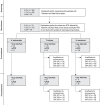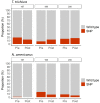Single-Nucleotide Polymorphisms in the Beta-Tubulin Gene and Its Relationship with Treatment Response to Albendazole in Human Soil-Transmitted Helminths in Southern Mozambique
- PMID: 35895348
- PMCID: PMC9490645
- DOI: 10.4269/ajtmh.21-0948
Single-Nucleotide Polymorphisms in the Beta-Tubulin Gene and Its Relationship with Treatment Response to Albendazole in Human Soil-Transmitted Helminths in Southern Mozambique
Abstract
Soil-transmitted helminth (STH) cornerstone control strategy is mass drug administration (MDA) with benzimidazoles. However, MDA might contribute to selection pressure for anthelmintic resistance, as occurred in livestock. The aim of this study is to evaluate the treatment response to albendazole and the relationship with the presence of putative benzimidazole resistance single-nucleotide polymorphisms (SNPs) in the β-tubulin gene of STH in Southern Mozambique. After screening 819 participants, we conducted a cohort study with 184 participants infected with STH in Manhiça district, Southern Mozambique. A pretreatment and a posttreatment stool samples were collected and the STH infection was identified by duplicate Kato-Katz and quantitative polymerase chain reaction (qPCR). Cure rate and egg reduction rates were calculated. Putative benzimidazole resistance SNPs (F167Y, F200T, and E198A) in Trichuris trichiura and Necator americanus were assessed by pyrosequencing. Cure rates by duplicate Kato-Katz and by qPCR were 95.8% and 93.6% for Ascaris lumbricoides, 28% and 7.8% for T. trichiura, and 88.9% and 56.7% for N. americanus. Egg reduction rate by duplicate Kato-Katz was 85.4% for A. lumbricoides, 34.9% for T. trichiura, and 40.5% for N. americanus. Putative benzimidazole resistance SNPs in the β-tubulin gene were detected in T. trichiura (23%) and N. americanus (21%) infected participants at pretreatment. No statistical difference was observed between pretreatment and posttreatment frequencies for none of the SNPs. Although treatment response to albendazole was low, particularly in T. trichiura, the putative benzimidazole resistance SNPs were not higher after treatment in the population studied. New insights are needed for a better understanding and monitoring of human anthelmintic resistance.
Figures



References
-
- WHO , 2019. Soil-Transmitted Helminth Infections Fact Sheet. Geneva, Switzerland: World Health Organization.
-
- Prichard RK, 2017. Drug resistance in nematodes. Antimicrob Drug Resist 46: 689–704.
-
- Kaplan RM, Vidyashankar AN, 2012. An inconvenient truth: global worming and anthelmintic resistance. Vet Parasitol 186: 70–78. - PubMed
-
- Ghisi M, Kaminsky R, Mäser P. 2007. Phenotyping and genotyping of Haemonchus contortus isolates reveals a new putative candidate mutation for benzimidazole resistance in nematodes. Vet Parasitol 144: 313–320. - PubMed
Grants and funding
LinkOut - more resources
Full Text Sources

